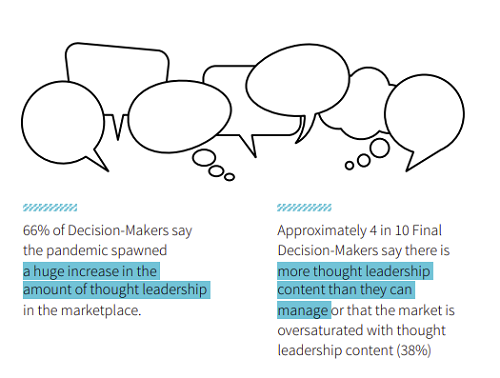SOCIAL
LinkedIn Shares New Research into Effective, and Ineffective, Thought Leadership Approaches

Looking to set a clearer direction for your content efforts, and better establish yourself or your business as a thought leader in your niche?
This will definitely help – this week, LinkedIn has published its 2021 B2B Thought Leadership Impact Study, created in conjunction with Edelman, which highlights the key challenges and issues in the modern content landscape, and the elements you need to focus on in your efforts.
The study incorporates responses from 3,593 global business executives, from a wide range of industries and company sizes, providing key insight into B2B market shifts, and how decision-makers see the current landscape.
Which could be great for your planning – first off, respondents indicated that the pandemic has sparked a flood of thought-leadership content, but much of it is… well, not great.

While 54% of decision-makers say that they spend more than an hour per week reading and reviewing thought leadership, much of what they’re seeing isn’t winning them over, with 71% noting that less than half of the thought leadership they consume gives them valuable insights.

Which means it’s not really thought leadership at all. In order to lead the way, you need to be sharing your own, unique thoughts, and providing a new way of looking at common problems or challenges, which can then establish you as a go-to voice in your niche.
In other words, many aspiring thought leaders are ‘doing the things’, but they’re failing to differentiate themselves or their ideas, instead choosing to copy key elements, and regurgitate common lines and mantras.
Which presents a significant opportunity. As has always been the case in the thought-leadership sphere, while anyone can write blog posts and distribute them across the world, very few people can actually communicate effectively, and provide a valuable perspective on the key shifts happening in their industry. Being able to write is one element, but taking the time to take a broader view, and consider what you, personally, think that each trend means, then having the courage to communicate that, is what truly defines a real thought ‘leader’ in this respect.
And that can have real, direct benefits.

In addition to this, effective thought leadership can also boost your branding efforts, with 63% of buyers saying that thought leadership “is important in providing proof that an organization genuinely understands or can solve your specific business challenges”.
The benefits are clear, but the challenge clearly lies in effective communication. You can’t simply assign a junior staff member to put together a few social media posts, nor can you expect your senior executives to be masters of written communication. Each element takes time and experience, and you need to invest in that effort, with a structured, defined process and approach, that will help to build your brand with every post and update.
And again, while anyone can write, great communication is a learned skill, and if you don’t have that capacity, you will fall short.

The same with research and expertise:

In essence, the guide underlines the value of taking a more dedicated, focused approach to your content marketing effort, not just posting the latest news on your website and hoping to generate response. You need to consider the purpose of every post, every article you create. What value will your audience glean from this? What unique perspective are you providing that they can’t get anywhere else?
Filling your content calendar to keep your social media profiles active is not a strategy – you need to consider how every update you share relates back to your brand goals, and further underlines your brand as a key leader in your niche.
This takes time and effort, and dedicated investment for most organizations. But as shown in these responses, that process can pay off, especially as more low quality content spills across the web.
You can read the full Edelman/LinkedIn 2021 B2B Thought Leadership Impact Study here.
SOCIAL
Snapchat Explores New Messaging Retention Feature: A Game-Changer or Risky Move?

In a recent announcement, Snapchat revealed a groundbreaking update that challenges its traditional design ethos. The platform is experimenting with an option that allows users to defy the 24-hour auto-delete rule, a feature synonymous with Snapchat’s ephemeral messaging model.
The proposed change aims to introduce a “Never delete” option in messaging retention settings, aligning Snapchat more closely with conventional messaging apps. While this move may blur Snapchat’s distinctive selling point, Snap appears convinced of its necessity.
According to Snap, the decision stems from user feedback and a commitment to innovation based on user needs. The company aims to provide greater flexibility and control over conversations, catering to the preferences of its community.
Currently undergoing trials in select markets, the new feature empowers users to adjust retention settings on a conversation-by-conversation basis. Flexibility remains paramount, with participants able to modify settings within chats and receive in-chat notifications to ensure transparency.
Snapchat underscores that the default auto-delete feature will persist, reinforcing its design philosophy centered on ephemerality. However, with the app gaining traction as a primary messaging platform, the option offers users a means to preserve longer chat histories.
The update marks a pivotal moment for Snapchat, renowned for its disappearing message premise, especially popular among younger demographics. Retaining this focus has been pivotal to Snapchat’s identity, but the shift suggests a broader strategy aimed at diversifying its user base.
This strategy may appeal particularly to older demographics, potentially extending Snapchat’s relevance as users age. By emulating features of conventional messaging platforms, Snapchat seeks to enhance its appeal and broaden its reach.
Yet, the introduction of message retention poses questions about Snapchat’s uniqueness. While addressing user demands, the risk of diluting Snapchat’s distinctiveness looms large.
As Snapchat ventures into uncharted territory, the outcome of this experiment remains uncertain. Will message retention propel Snapchat to new heights, or will it compromise the platform’s uniqueness?
Only time will tell.
SOCIAL
Catering to specific audience boosts your business, says accountant turned coach

While it is tempting to try to appeal to a broad audience, the founder of alcohol-free coaching service Just the Tonic, Sandra Parker, believes the best thing you can do for your business is focus on your niche. Here’s how she did just that.
When running a business, reaching out to as many clients as possible can be tempting. But it also risks making your marketing “too generic,” warns Sandra Parker, the founder of Just The Tonic Coaching.
“From the very start of my business, I knew exactly who I could help and who I couldn’t,” Parker told My Biggest Lessons.
Parker struggled with alcohol dependence as a young professional. Today, her business targets high-achieving individuals who face challenges similar to those she had early in her career.
“I understand their frustrations, I understand their fears, and I understand their coping mechanisms and the stories they’re telling themselves,” Parker said. “Because of that, I’m able to market very effectively, to speak in a language that they understand, and am able to reach them.”Â
“I believe that it’s really important that you know exactly who your customer or your client is, and you target them, and you resist the temptation to make your marketing too generic to try and reach everyone,” she explained.
“If you speak specifically to your target clients, you will reach them, and I believe that’s the way that you’re going to be more successful.
Watch the video for more of Sandra Parker’s biggest lessons.
SOCIAL
Instagram Tests Live-Stream Games to Enhance Engagement

Instagram’s testing out some new options to help spice up your live-streams in the app, with some live broadcasters now able to select a game that they can play with viewers in-stream.
As you can see in these example screens, posted by Ahmed Ghanem, some creators now have the option to play either “This or That”, a question and answer prompt that you can share with your viewers, or “Trivia”, to generate more engagement within your IG live-streams.
That could be a simple way to spark more conversation and interaction, which could then lead into further engagement opportunities from your live audience.
Meta’s been exploring more ways to make live-streaming a bigger consideration for IG creators, with a view to live-streams potentially catching on with more users.
That includes the gradual expansion of its “Stars” live-stream donation program, giving more creators in more regions a means to accept donations from live-stream viewers, while back in December, Instagram also added some new options to make it easier to go live using third-party tools via desktop PCs.
Live streaming has been a major shift in China, where shopping live-streams, in particular, have led to massive opportunities for streaming platforms. They haven’t caught on in the same way in Western regions, but as TikTok and YouTube look to push live-stream adoption, there is still a chance that they will become a much bigger element in future.
Which is why IG is also trying to stay in touch, and add more ways for its creators to engage via streams. Live-stream games is another element within this, which could make this a better community-building, and potentially sales-driving option.
We’ve asked Instagram for more information on this test, and we’ll update this post if/when we hear back.
-

 PPC6 days ago
PPC6 days agoCompetitor Monitoring: 7 ways to keep watch on the competition
-

 SEARCHENGINES6 days ago
SEARCHENGINES6 days agoMore Google March 2024 Core Update Ranking Volatility
-

 PPC6 days ago
PPC6 days ago31 Ready-to-Go Mother’s Day Messages for Social Media, Email, & More
-

 PPC6 days ago
PPC6 days agoA History of Google AdWords and Google Ads: Revolutionizing Digital Advertising & Marketing Since 2000
-

 WORDPRESS7 days ago
WORDPRESS7 days agoThrive Architect vs Divi vs Elementor
-

 WORDPRESS5 days ago
WORDPRESS5 days agoTurkish startup ikas attracts $20M for its e-commerce platform designed for small businesses
-

 MARKETING5 days ago
MARKETING5 days agoRoundel Media Studio: What to Expect From Target’s New Self-Service Platform
-

 SEARCHENGINES5 days ago
SEARCHENGINES5 days agoGoogle Search Results Can Be Harmful & Dangerous In Some Cases


